| http://www.chemistrymag.org/cji/2006/08b071pe.htm | Nov. 9,
2006 Vol.8 No11 P.71 Copyright |
Ultrasonic slurry sampling hydride generation atomic fluorescence spectrometry: determination of trace cadmium in soil
Liang Shuxuan1, Lv Tianfeng1,
Sun Hanwen1, Qiao Fengxia1, Liu Aichang2
(1College of Chemistry and Environmental Science, Hebei University, Key
Laboratory of Analytical Science and Technology of Heibei Province, Baoding 071002; 2China
Metallurgy Perambulation Design Academe of limited company, Bao Ding, 071069, China)
Abstract A method has been developed for
the determination of cadmium in soil by ultrasonic slurry sampling hydride generation
atomic fluorescence spectrometry (USS–HG-AFS).
Approximately 500 mg, ground to a particle size about 80mm, was mixed with hydrochloric acid solution and agar solution. The
samples are agitated for 15 min in an ultrasound water bath. The described procedure
permits the use of direct calibration for the determination of cadmium in several soil
samples. The influences of instrument operating conditions, slurry preparation and
interferences on the signals and the accuracy and precision were determined, with the
thiourea and antiscorbutic acid addition as masking reagent that can eliminate the
disturbance of partial coexistences ion in the soil,with
the Co2+ addition that can intensify the Cd hydride generation efficiency. The
results for the reference soil sample GBW-07411 agreed satisfactorily with the certified
values. The recoveries of the analytes varied in the range from 93 to 104 %. The detection
limit was 7.5 ngL-1 of Cd. The relative standard deviations were lower than 5.3
%, demonstrating a good precision for slurry analysis.
Keywords Hydride generation; ultrasonic slurry sampling; Atomic fluorescence
spectrometry; soil; Cadmium
The increasing global emission of Cd compounds mainly related to the Cd industry into the atmosphere, together with aqueous and solid emissions lead to local contamination problems[1]. All these practices produce an accumulation of Cd in soils, allowing it to enter the food chain with the potential to cause serious health problems. Its strong tendency to accumulate in organism makes it one of the most dangerous metals to humans. Occupational exposure to cadmium has long been known to be harmful to the kidney, lung and liver[2]. Such reasons explain the need to monitor Cd in environmental samples.
Among these most extensively used method is atomic absorption spectrometry by using flame (FAAS) or graphite furnace (ETAAS). Nowadays, hydride generation atomic fluorescence spectrometry (HG-AFS) offers a relatively low-cost and highly sensitive alternative for the determination of Cd.
The traditional pretreatment of solid samples to dissolve the Cd species is an acid digestion procedure. However, this procedure is time consuming, require adequate laboratory conditions and make use of large quantities of glassware and reagents, increasing the risks of analyte contamination or loss. An alternative for the pretreatment of solid samples is the slurry formation by using the ultrasonic power and direct analysis of the solid suspension. Compared with traditional sample preparation methods, slurry formation combines the benefits of the solid and liquid sampling, avoiding the contamination and the loss of volatile elements and reduced sample amount needed. This mode has been extensively used in AAS[3-5], ICP-MS[6,7] and AFS[8-10].
To the best of our knowledge, no applications have been reported in the literature concerning the determination of Cd in soil by slurry sampling AFS. The main goal of this work is to develop new analytical methodologies based on the use of ultrasonic slurry sampling for fast and accurate determination of Cd in soil by HG-AFS. In this study, the instrument operating conditions, slurry preparation, particle size, slurry stability, acidity of the medium, accuracy and precision of the method have been optimized. Finally, data for different soil samples were compared with those found after acid digestion, demonstrating that the traditional acid digestion of the samples can be avoided by ultrasonic slurry sampling. This method was applied to the determination of Cd in reference material and some soil samples. 2. EXPERIMENTAL
2.1 Instrumentation
A hydride generation atomic fluorescence spectrometer AFS-230 (Beijing Haiguang Instrumentals Co. Ltd., Beijing, China) equipped with hollow cathode lamps(Beijing Vacuum Electronics Research Institute, Beijing, China) was employed for determination of Cd. Intermittent flow manifold was in Fig.1. The instrumental parameters were in Table.1.
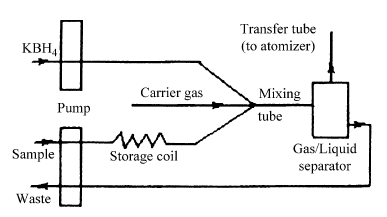
Fig. 1 Intermittent flow manifold
Table 1 Parameters of the HG-AFS instrument
Parameters |
Conditions |
PTM voltage (V) |
300 |
Atomizer temperature (℃) |
200 |
Atomizer height (mm) |
8 |
Lamp current (mA) |
60 |
Flow rate of carrier gas (Ar) (mL min-1) |
700 |
Flow rate of shield gas (Ar) (mL min-1) |
800 |
Read mode |
Peak area |
Measure method |
Std. curve |
Read time(s) |
10 |
Delay time(s) |
1 |
Read repeat(times) |
3 |
Injection volume (mL) |
0.5 |
An intermittent flow hydride generation system was employed throughout this work and the schematic diagram of the system is shown in Fig.1. The working of the system can be programmed in several steps for each measurement, at every step the rotation rate and time of the two peristaltic pumps used in this work are listed in Table. 2.
Table 2 Program of intermittent flow
Step |
Time(s) |
Rotation rate |
Read |
1 |
6 |
0 |
No |
2 |
10 |
100 |
No |
3 |
6 |
0 |
No |
4 |
16 |
120 |
Yes |
An ultrasound vibrator (KQ3002B, Kunshan, China) was used to stir the samples with agar solution before hydride generation.
2.2 Reagents
All chemicals were of highest available purity, Ultrapure water (18.3W) was used throughout.
The 1.0mgmL-1 of cadmium stock solution(10 % HCl, GSB
G62040-90) was purchased from the National Center for Analysis and Testing of Steel
Materials. The working standards were obtained from the stock solution after dilution with
1% (v/v) HCl prior to use.
The KBH4 solutions were daily prepared by dissolving proper
amounts of KBH4 in 0.5 % (m/v) NaOH solution.
The thiourea and ascorbic acid solution of 50 gL-1 was
prepared by dissolving 5.0 g ascorbic acid and 5.0 g thiourea in 100 mL water.
1000 mgL-1of Co stock solution was prepared by dissolving a
precisely weighted amount of high pure CoCl2 (Tianjin Chemicals) in 100mL
water. The agar solution (2.0gL-1) was prepared by dissolving 1.0 g agar
(Haiyang, Guangdong) in 500 mL boiled water.
5% (v/v) HCl used for carrier solution and 10 % (v/v) HCl used in
sample treatment was prepared from high purity grade.
NaOH, HNO3 and H2SO4 were of high
purity grade.
2.3 Experimental procedure
2.3.1 Soil properties
The soils used in this study were obtained from the main agricultural areas in Baoding
(China) varying widely in physicochemical properties. The soil samples, collected from the
surface horizon (0-15cm), were air dried and mildly
ground to pass through a 80
2.3.2 Slurries preparation
Slurries were prepared by accurately weighing 500 mg soil sample in 50 mL glass flasks and adding 15 mL 10 %(v/v) HCl, 20mL agar solution (2.0gL-1), 10 mL thiourea-ascorbic acid solution of 50gL-1, 0.5mL 1000 mgL-1 of Co2+ solution, then diluted to the mark with ultrapure water. The resulting slurries were dispersed with an ultrasonic vibrator for 15 min in order to obtain homogeneous dispersions. The aqueous standard solutions, in which the concentration of cadmium varied from 0 to 10mgL-1, were prepared as slurries containing 0.8gL-1agar, 3 % (v/v) HCl and 1.0% (m/v) thiourea and ascorbic acid and 1.0 mgL-1 Co2+ by the above mentioned procedure and used for calibration.
2.3.3 Wet digestion
For comparison, determinations were also performed with wet digestion of compost samples. Test portions (500mg) were accurately weighed into borosilicate glass vessels and 1mLconcentrated HNO3, and 3 mL concentrated HCl were added. Then the solution was boiling for 2 hours. 2 mL HClO4 was added in the solution, which was going on boiling until dried. The solution obtained was transferred to a volumetric flask with addition of 30 mL 10%(v/v) HCl, 20 mL 50gL-1 of thiourea and ascorbic acid solution, and 1.0 mL 1000 mgL-1 of Co2+solution, then diluted to 100 mL with water.
2.3.4 Analytical procedure
Total Cd in the sample slurry and the aqueous standard solutions are merged with KBH4 to form the hydrides. The analytes were determined by AFS under the optimized experimental conditions indicated in Table 1 and 2. 3. RESULTS AND DISCUSSIONS
3.1 Choice of slurry medium
Slurry preparation in aqueous solution is rarely suitable because most powdered materials undergo rapid sedimentation. This sedimentation of suspended material usually occurs after mixing the slurry. The sedimentation rate depends on the densities of the diluent and solid material, the viscosity of the diluent medium and the radius of the sample particles. The slurry can be stabilized using a highly viscous liquid medium. So far, agar[11,12], glycerol[13], enthanol[14] and Triton-x100[15] have been used as slurry stabilizing agents. In this study, the results showed that the viscosity of agar kept different types of particles in suspension for a sufficient time. Furthermore, it has been stated that the optimum concentration of agar was 0.08 % (m/v) for the homogenization of slurry soil samples. Therefore, in the present work, 2.0 gL-1 agar solution is used as the slurry stabilizing agent.
3.2 Effect of particle size
The particle size of the solid material can influence the stabilization and deposition of the slurry, which in turn can influence both accuracy and precision. In the studies, the effect of different particle sizes of soil was investigated. Sample separation in different particle size fractions were carried out by sieving. With the variation in particle size, significant changes in suspended time were observed. The suspended time gradually increased with decreasing particle size, down to the range 76mm-80mm. It was shown the good dispersion and homogeneity of relatively small suspended particles. When the particle size<70mm, the suspend time reached a plateau(Fig. 2). So the particle size range 76mm-80mm was selected.
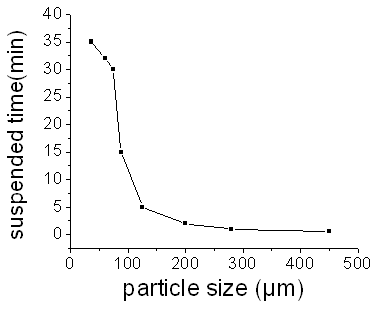
Fig.2 Effect of the particle size of soil sample on the suspended time
3.3 Influence of KBH4
concentrations
In the present method, potassium tetrahydroborate(KBH4) solution was used
as both reducing agent and hydrogen supplier. The results shown that the signal
intensities of analytes would increase when the concentration of KBH4 solution
increased from 0.5 to 2 % (m/v), but the signal stability and intensity decreased when the
concentration were higher than 2 % (m/v). This is obviously described to the fact that an
increase of the reducing reagent concentration corresponds to the formation of more
hydride molecules, but too high a concentration tends to produce concomitantly more
hydrogen molecules in the gas phase, and the concentration of the hydride was diluted,
thus caused a drop in the sensitivity. Hereby, KBH4 solution of 2 % (m/v) was
applied to all determinations. The results were presented in Fig. 3.
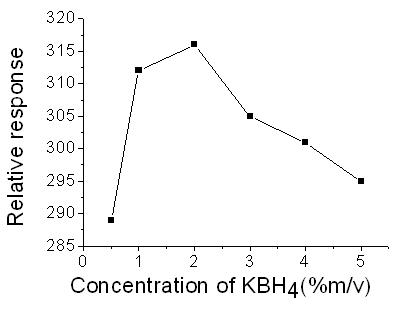
Fig. 3. Effect of KBH4 concentrations on Cd
HG.
Carrier solution, 5 % (v/v) HCl; Cd solution, 2 mgL-1 in 3 % (v/v) HCl,
containing 1.0 mgL-1 of Co2+; 1.0 % (m/v) thiourea and ascorbic
acid.
3.4 Acidity effects
Acidity of the solution is a very important parameter that has great influence on the
hydride generation, and even critic. In this study, the acidic medium concentration
effects of H2SO4, HNO3 and HCl on Cd hydride generation
were investigated. The results were presented in Fig. 4. As can be seen in Fig. 4, the Cd
signal intensity of HCl system was much higher than HNO3 and H2SO4
systems. So 3 % (v/v) HCl was the most suitable acidity.
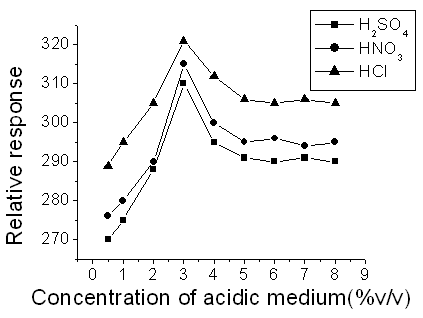
Fig. 4. Effect of acidic medium concentration on Cd
HG.
Reductant solution, 2 %(m/v) KBH4; Cd solution ,2
containing 1.0 mgL-1 of Co2+; 1.0 % (m/v) thiourea and ascorbic acid.
3.5 Cd hydride generation efficiency
enhancement
In previous works, it was widely reported that, in the HCl system, Co2+ acting
as a catalyzer that would enhance the Cd hydride generation efficiency to a great extent[16].
In this study, it was necessary to investigate the roles of Co2+ on the Cd
hydride generation efficiency enhancement. As can be seen in Fig. 5, the presence of Co2+
significantly enhanced the Cd hydride generation efficiency, however, a maximum
enhancement was reached at 1.0 mgL-1of Co2+. The results were
presented in Fig. 5.
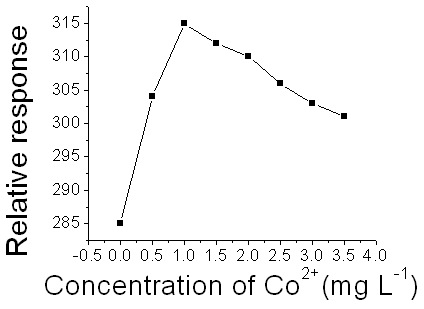
Fig. 5 Effect of Co2+
concentration on Cd HG.
Reductant solution, 2 %(m/v) KBH4; Carrier solution, 5 %(v/v) HCl ; Cd
solution,
2 mgL-1
in 3 % (v/v) HCl, containing 1.0 % (m/v) thiourea and ascorbic acid.
3.6 Effect of thiourea and ascorbic acid
Thiourea and ascorbic acid can influence both accuracy and precision of test, while
can eliminate the disturbance of partial coexistences ion in the soil. The concentration
of thiourea and ascorbic acid was investigated from 0.0 % (m/v) to 2.5 % (m/v). The signal
intensity was stable as the concentration of thiourea and ascorbic acid from 0.2 % (m/v)
to 2.5 % (m/v) and thiourea and ascorbic acid have no contribution to the improvement of
Cd signal in this work. In fact, thiourea was deduced to act as a masking reagent more
than a catalyzer. So 1.0 % (m/v) thiourea and ascorbic acid was chosen. The results were
presented in Fig. 6.
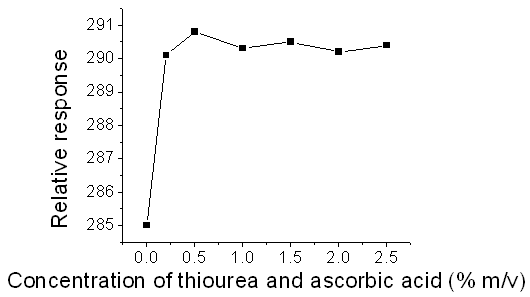
Fig. 6 Effect of thiourea and ascorbic
acid concentration on Cd HG.
Reductant solution, 2 %(m/v) KBH4; Carrier solution, 5 %(v/v) HCl ;
Cd solution ,2
3.7 Interference studies
2
3.8 Analytical performance
A successive measurement of a 0.2 mgL-1of Cd solution gave a RSD of 3.1 % for eleven runs, which indicated good reproducibility of the proposed method.
The analysis of a series solutions containing 0.0,2.0,4.0,6.0,8.0,10.0 mgL-1 of Cd, respectively, gave a calibration function of If = 2.8+15.84X (If, the signal intensity and X, the concentration of Cd, expressed in mgL-1), of which the correlation coefficient is 0.9997.
The detection limits (DL) for Cd species was evaluated on the basis of the standard deviation (S.D.) of the measured signals (11 times) for the blank solution, and was calculated by the formulate DL=3S.D.K-1 (here K is the slopes of the calibration graph). As results, the detection limits was 7.5 ngL-1.
The feasibility of the method was evaluated by analyzing the standard reference material of GBW07411. The results listed in Table 3 reveal that this method is of high accuracy and precision. The results were presented in Table 3.
Table 3 Analysis of standard reference materials
Sample |
Certified ( mgg-1)a |
Found ( mgg-1)a |
Soil(GBW07411) |
28.2±1.3 |
28.6±0.75 |
a
means and standard deviations from 7 replicate measurements.3.9 Soil sample analysis
The proposed USS-HG-AFS method was applied to the determination of trace amounts of Cd
in soil samples collected from suburb cropland. The Cd content of soil samples was shown
in Table 4. Results from USS-HG-AFS are in good agreement with those obtained after acid
digestion. The recovery of Cd from soil samples was in the range of 93-104 %. The RSD was
from 3.8-5.3 %. This is indicative of excellent recovery of copper. The results were
presented in Table 4.
Table 4 Results from determination of cadmium in soil samplesa
Sample |
Found |
RSD(%) |
Added |
Total |
Recovery |
Acid digestion |
1 |
0.52±0.020 |
3.8 |
0.30 |
0.81±0.025 |
99 |
0.51±0.016 |
2 |
0.63±0.025 |
4.0 |
0.30 |
0.95±0.015 |
102 |
0.66±0.013 |
3 |
0.25±0.010 |
4.0 |
0.30 |
0.52±0.025 |
95 |
0.25±0.018 |
4 |
0.31±0.012 |
3.9 |
0.30 |
0.64±0.012 |
104 |
0.32±0.008 |
5 |
0.15±0.008 |
5.3 |
0.30 |
0.42±0.013 |
93 |
0.18±0.014 |
a
means and standard deviations from 5 replicate measurements 4. CONCLUSIONThe developed procedure offers a simple and convenient alternative to those based on a previous complete digestion of samples for the determination of Cd in soil. This method, based on the excellent sensitivity attainable by AFS and on a soft room-temperature treatment of the samples, is a safe and comfortable methodology for operators, which reduces the reagent consumption and time of analysis and offers a possibility to explore the presence of Cd in soil. The developed method is simply and accurate, so is promising for routine analysis of trace of Cd in other more complex materials.
Acknowledgement This work was supported by Nature Science Foundation of HeBei province, China, for much support to the studied subject(230110).
REFERENCES[1] Li J.Q., Chen X.Y., Tang Y.J., et al, China public health, 2001, 17: 196.
[2] Liu Z.P., Scientia agricultura sinica, 2005, 28: 185.
[3] Mierzwa J., Sun Y.C., Chung Y.T., et al, Talanta, 1998, 47: 1263.
[4] Silva D., Erik G.P., Santos, et al, Microchemical Journal, 2006, 82: 159.
[5] Mena M.L., Gomez M.M., Palacios M.A., et al, Laboratory Automation and Information Management, 1999, 34: 159.
[6] Wagner B., Garbos S., Bulska E., et al, Spectrochimica. Acta. Part B, 1999, 54: 797.
[7] Anderson S.R., Mariana A.V., Adilson J.C., Spectrochimica. Acta. Part B, 2004, 59: 243.
[8] Patricia C.M., Cervera M. L., Pastor A., Miguel G., Talanta, 2004, 62: 175.
[9] Patricia C.M., Eva R.T., ángel M.R., Luisa C.M, Analytica Chimica Acta, 2004, 506: 145.
[10] Capelo J.L., Fernandez C., Pedras B., et al, Talanta, 2006, 68: 1442.
[11]Feng G.G. , Tao J., Shen N. H., Environmental Monitoring in China, 2005, 17: 28.
[12] Deng S.L., Li X.F., Zhou P. Spectroscopy and Spectral Analysis, 1996, 16: 106.
[13] Kiewicz D.B., Siepak J., Anal Chim Acta, 2001, 437: 11.
[14] Li L.D., Metallurgical Analysis, 2000, 20: 58.
[15] Liu H.D., Liu T., Yong Q., et al, Earth Science-Journal of China University of Geosciences, 2000, 25: 532.
[16] Duana T.C., Songa X. J., Jin D., et al, Talanta, 2005, 67: 968.
超声波辅助悬浮进样氢化物发生原子荧光光谱法:测定土壤中的镉
梁淑轩1 吕天峰1 孙汉文1乔凤霞1刘爱厂2
(1河北大学化学与环境科学学院,河北省分析科学技术重点实验室,071002, 保定;2中勘冶金勘察设计研究院有限责任公司,071069,保定,中国)
摘要 本文采取超声波辅助悬浮进样氢化物发生原子荧光光谱法测定土壤中的镉含量。取500毫克(经过研磨粒径约为80微米)的土壤样品与盐酸和琼脂溶液混合。在超声波水浴中震荡15分钟,使土壤样品均匀悬浮于琼脂溶液中。这种方法可以用来直接测定不同土壤样品的镉的含量。实验中讨论了仪器操作条件,样品的预处理,以及其它影响实验信号值、准确性、灵敏度的影响因素。本实验采用硫脲-抗坏血酸作为掩蔽剂同时可以消除土壤中共存离子的干扰,加入钴离子可以增强镉的氢化物的发生效率。通过对标准土壤样品(序列号 GBW-07411)的测定,证明该方法的准确性。对实际样品进行测定,检出限可达7.5ngL-1,相对标准偏差低于5.3%,回收率可达95-104%,都证明方法的准确性。
关键词 氢化物发生,超声波辅助悬浮进样,原子荧光光谱法,土壤,镉